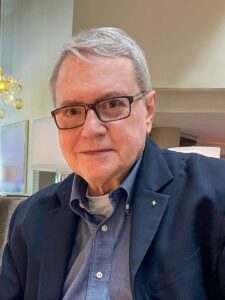
When Philip D. Spiess II speaks of Cincinnati, you can see the glimmer of Music Hall’s chandeliers in his eyes. Although he has spent five decades on the East Coast, his heart remains in Cincinnati, where he grew up in the sixth generation of German immigrants. His family’s story is the quintessential Cincinnati story — his love of music and history is part of his DNA.
Born in 1946, some of his first memories are band concerts in Burnet Woods with his parents, who reminisced he was always conducting, especially to Sousa marches. Growing up in Clifton, he took piano lessons, sang in school and church choir with his sister Barbara, and at Walnut Hills High School played clarinet in the marching and concert bands. Commissioned to create a historical bus tour of the Clifton neighborhood after graduation led to his discovered passion for local history and a job as a research assistant at the Cincinnati Historical Society.
After earning his B.A. in English from Hanover College, Spiess attended several graduate programs, including the University of Delaware (M.A. in history), Indiana University (M.A. in English), and Drew University (M.Phil., 19th-century studies). For 48 years, he worked at some of the most prestigious historical institutions in the U.S., including the New York State Historical Association, the National Trust for Historic Preservation, and the Smithsonian Institution’s Office of Museum Programs. He taught at the University of Mary Washington in Fredericksburg, Virginia, where he established its undergraduate degree program in historic preservation and museum studies, and its Center for Historic Preservation. Spiess was a professorial lecturer in the graduate museum studies program at George Washington University in Washington, D.C., for 30 years.
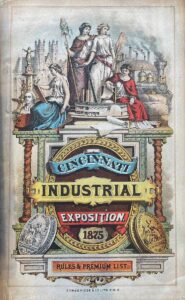
He “wrote the book” on the history of Music Hall’s expositions, with his master’s thesis for the University of Delaware, “The Cincinnati Industrial Expositions (1870-1888): Propaganda or Progress?” completed in 1970, the centennial year of the first Grand Industrial Exposition. It is still one of the most thoroughly researched works on these annual and three-month-long shows exhibiting arts, inventions, and horticulture. What began as a collection of primary archival materials used for the thesis continued to grow for over a half-century but recently has found its way back home. Thea Tjepkema, FMH Archivist, Historian, and Historic Preservationist, found his multiple resources while researching Music Hall history, and they sparked a professional friendship.
Spiess Donations to the Friends of Music Hall Archives
In 2019, Spiess began the process of donating his extensive collection to the FMH Archives with a rare photo of the statue modello of the Angel of Music intended for the apex of Music Hall and one of the earliest photos of Music Hall c. 1883-1888 with all its sandstone finials and metal roof ornamentation, which aided Tjepkema in research for their restoration. In May of 2024, Spiess donated an additional 63 items, primarily focused on industrial expositions, including annual commissioners’ reports, rules, premium lists, and catalogues; books, sheet music, guides, programs, tokens, souvenirs, ribbons, and entrance tickets to expositions. Spiess also donated two more rare photographs, one by Cincinnati photographer Charles Waldack, a Carte-de-Viste of Exposition Hall c. 1872-1873, and a 1910 photo of the South Hall, set up as the Junior Auxiliary Hall for the Episcopal Church Convention.
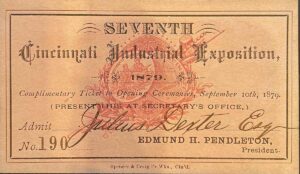
Spiess Donation (FMH 2024.5.47)
Music Hall Memories
Philip Spiess recalls with greatest pleasure his Clifton School field trips to Music Hall to hear the Young People’s Concerts led by the Cincinnati Symphony Orchestra’s 7th Music Director Thor Johnson. His middle school class sang on Cincinnati’s early educational television station WCET in Dexter Hall (now Corbett Tower). He sang in the May Festival Children’s Chorus and recalls standing behind Ogden Nash, who read his comic verses to Saint-Saens’ Carnival of the Animals. Unforgettable was Mary Martin soaring over the stage as Peter Pan; Victor Borge’s classical slapstick at the piano; receiving a personalized autograph of Beverly Sills after an opera performance; and watching Prof. Peter Schickele (a.k.a. P.D.Q. Bach), running along the third-floor balcony’s edge, climbing down the proscenium arch only to take a pratfall crossing the stage. Spiess also remembers dancing in the Topper Ballroom with his cousin Barbara Jane Goepp at her high school Prom. He regularly attended the Cincinnati Symphony Orchestra concerts in Music Hall before leaving town in 1972. Although his career took him to New York, and then, where he is now retired, Washington, D.C., he still regularly contributes to the Walnut Hills High School Class of 1964 Forum website, with frequent blogs about Cincinnati history.

by Herman Gerold 1888,
Spiess Donation (FMH 2024.3.36)
Spiess’s Career Began with Cincinnati History
Spiess II’s connection to Cincinnati and Music Hall began with a family of German immigrants, a love for music, and a career centered around history. Spurred by his great-grandmother, Amelia Feid Foerster’s (1872-1963) stories of growing up here, his interest in the city’s history grew. Amelia’s father, George Frederick Feid (1839-1921), emigrated with his family from Hesse-Darmstadt to Over-the-Rhine (OTR) at the age of nine, fought in the Civil War with the 9th Ohio Volunteer Infantry Regiment (Die Neuner), and sang in a men’s group that formed at Grammer’s German restaurant.
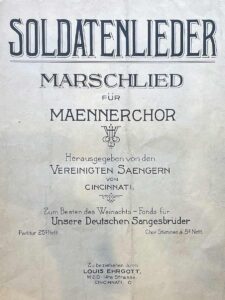
Spiess Donation (FMH 2024.3.40)
There were 61 German singing societies in Cincinnati by the time Saengerhalle was constructed. The most prominent, the Cincinnati Maennerchor officially formed in 1857 in a grove of trees just a few blocks west of the Protestant Orphan Asylum, on the Music Hall lot before Saengerhalle. The Maennerchor participated in the opening of Saengerhalle in 1870 with a Saengerfest and the final Music Festival in Old Exposition Hall in 1876. The last Music Director was Louis Ehrgott.
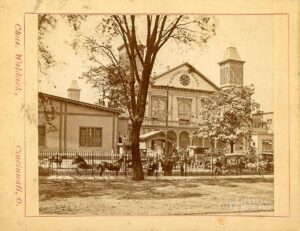
On the lot where Music Hall stands today, the first six Grand Expos were held (1870-1875) in Saengerhalle or Exposition Hall. As of 1879, the completed Music Hall with wings hosted eight subsequent events (between 1879 and 1888). Saengerhalle and then Music Hall were the city’s large events centers. Saengerhalle hosted the first two May Festivals, political conventions, and annual Grand Industrial Expositions, with additional temporary buildings in Washington Park, becoming known as Exposition Hall. The success of Saengerhalle’s many community gatherings and the city’s affection for music brought by early immigrants inspired the construction of Music Hall in the heart of OTR. Philip Spiess’s relatives on both sides witnessed the construction of Saengerhalle and then Music Hall and most likely attended various events inside.
The spirits of Spiess’s Cincinnati relatives, who perhaps strolled the halls for concerts or expositions in Saengerhalle or Music Hall in the nineteenth century, live in his stories and gifts. His love of music, opera, history, and Cincinnati continues today.
The Friends of Music Hall thank Philip D. Spiess II for donating his saved treasures, including his memorable stories, to help unlock clues to Music Hall’s history.
